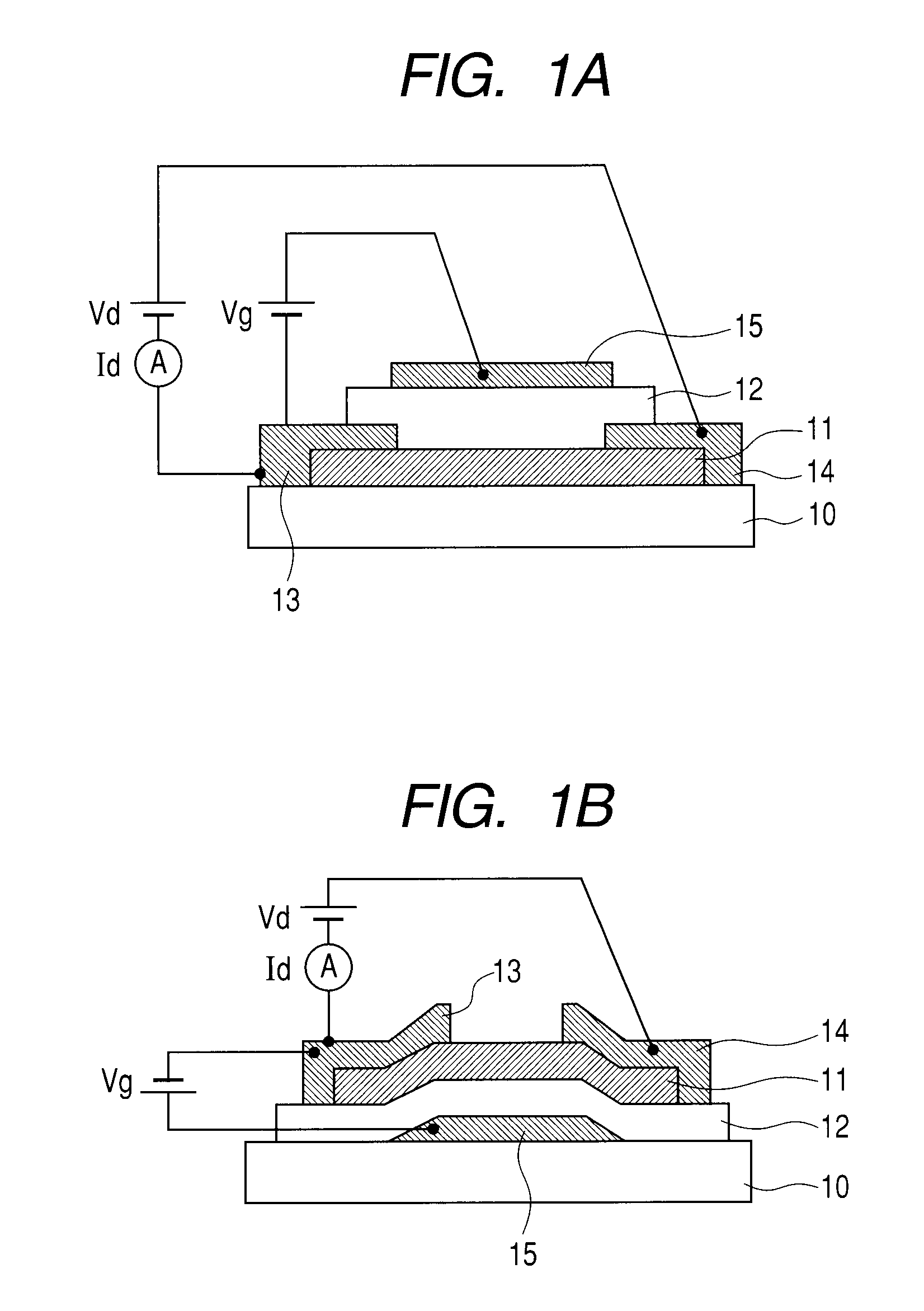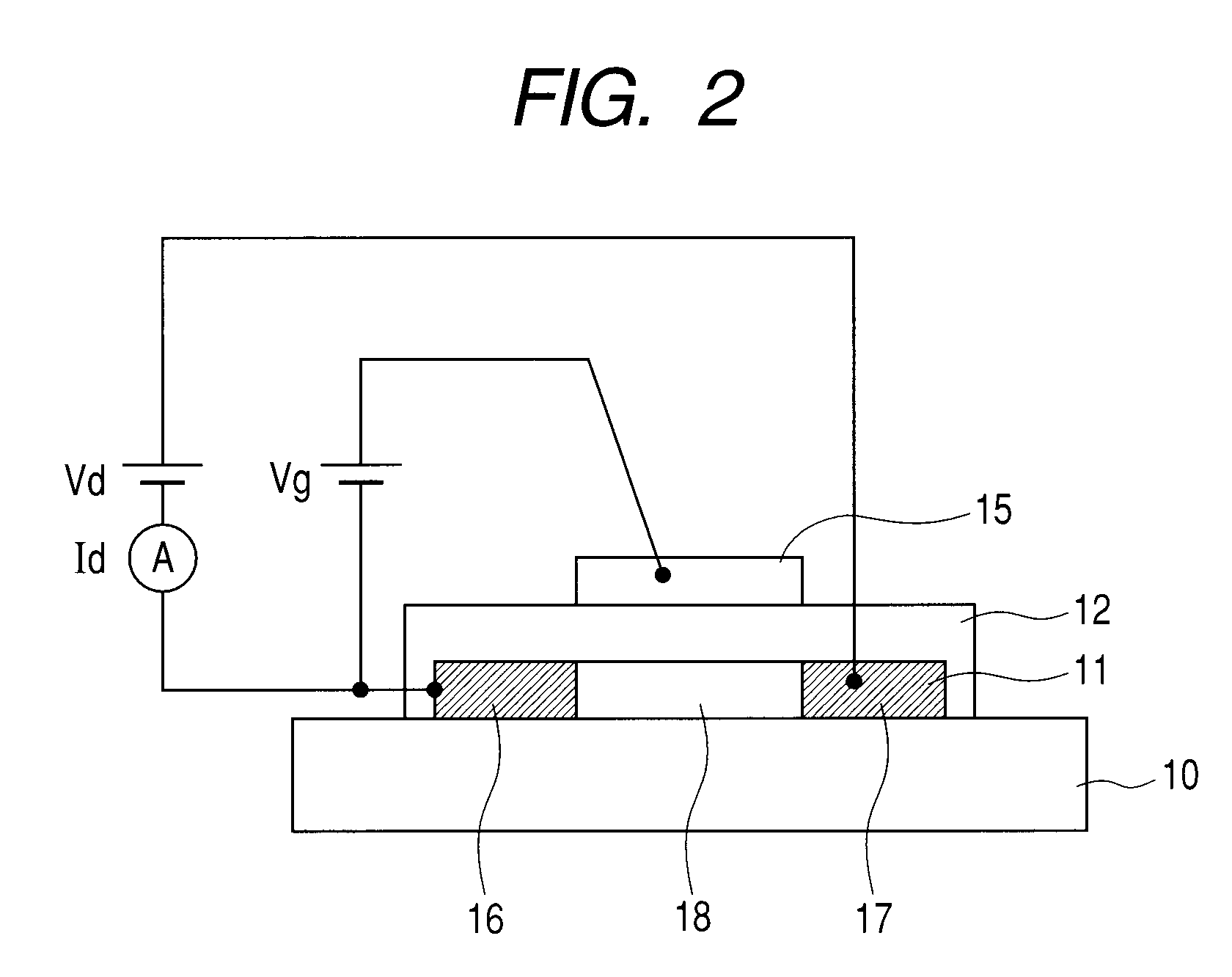Field effect transistor and process for production thereof
a field effect transistor and transistor technology, applied in the direction of semiconductor/solid-state device details, electrical equipment, semiconductor devices, etc., can solve the problems of difficult formation of thin films on substrates, less reliable, and gold does not have sufficient adhesiveness to an oxide semiconductor
- Summary
- Abstract
- Description
- Claims
- Application Information
AI Technical Summary
Benefits of technology
Problems solved by technology
Method used
Image
Examples
example 1
[0068]FIG. 1A illustrates a top-gate type TFT of this Example. Channel layer 11 is a film of an amorphous oxide semiconductor of In—Ga—Zn—O type. Source electrode 13 and drain electrode 14 are films of an oxynitride of an In—Ga—Zn—O—N type. A process for producing such a TFT is described below.
[0069]Firstly, an amorphous oxide semiconductor layer is formed as channel layer 11 on glass substrate 10 (made by Corning Co.: 1737). In this Example, the amorphous oxide film of an In—Ga—Zn—O type is formed by radio frequency sputtering method in an atmosphere of an argon-oxygen gas mixture. The sputtering is conducted by use of, as the target (material source), a polycrystalline sintered compact of InGaZnO4 in a size of 2 inches with the RF power input of 100 W, in an atmosphere of a gas mixture of Ar:O2 (flow rate ratio of 100:1) at a total gas pressure of 0.45 Pa at the substrate temperature of 25° C. The film deposition rate is 12 nm / min. After forming the film, the annealing is carried ...
example 2
[0081]FIG. 1B illustrates a bottom-gate type TFT of this Example. Channel layer 11 is a film of an amorphous oxide of Zn—In—O type. Source electrode 13 and drain electrode 14 are films of an oxynitride of a Zn—In—O—N type. A process for producing such a TFT is described below.
[0082]Firstly, a Mo film is formed in a thickness of 100 nm as the gate electrode on a glass substrate (made by Corning Co.: 1737) by sputtering.
[0083]Then a SiOx film is formed as gate electrode-insulating layer 12 in a thickness of 150 nm by sputtering.
[0084]Thereafter an amorphous oxide semiconductor film of a Zn—In—O type is formed as the channel layer by simultaneous sputtering by use of a ZnO target and an In2O3 target. In the sputtering, the mixing ratio of argon and oxygen is Ar:O2=80:1, film formation rate is 12 nm / min, the substrate temperature is 25° C., and the film thickness is about 30 nm. The formed Zn—In—O film is amorphous. The metal compositional ratio of Zn:In is 64:36. The thin film has no d...
example 3
[0091]FIG. 2 illustrates a coplanar type of the field effect transistor of this Example. FIG. 2 is a sectional view, in which the reference numerals denote the followings: 10, a substrate; 11, a channel layer (oxide thin film); 12, a gate insulating layer; and 15, a gate electrode. Channel layer 11 has three regions: source region 16 containing implanted nitrogen (corresponding to the source electrode in Example 1), drain region 17 containing implanted nitrogen (corresponding to the drain electrode in Example 1), and channel region 18 (corresponding to the channel layer in Example 1). Channel layer 11 is formed from In—Ga—Zn—O type amorphous oxide, and source region 16 and drain region 17 as the electrodes are formed therein by nitrogen ion implantation. FIGS. 7A, 7B, and 7C illustrate a process of formation of the source region and the drain region. The steps of formation of such a transistor are described below.
[0092]Firstly, an amorphous oxide layer is formed as channel layer 11 ...
PUM
 Login to View More
Login to View More Abstract
Description
Claims
Application Information
 Login to View More
Login to View More - R&D
- Intellectual Property
- Life Sciences
- Materials
- Tech Scout
- Unparalleled Data Quality
- Higher Quality Content
- 60% Fewer Hallucinations
Browse by: Latest US Patents, China's latest patents, Technical Efficacy Thesaurus, Application Domain, Technology Topic, Popular Technical Reports.
© 2025 PatSnap. All rights reserved.Legal|Privacy policy|Modern Slavery Act Transparency Statement|Sitemap|About US| Contact US: help@patsnap.com



